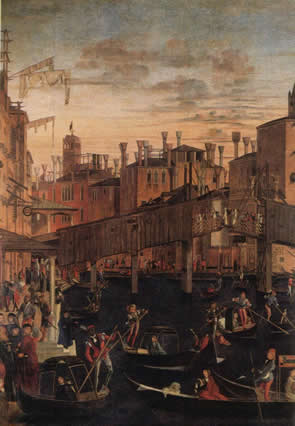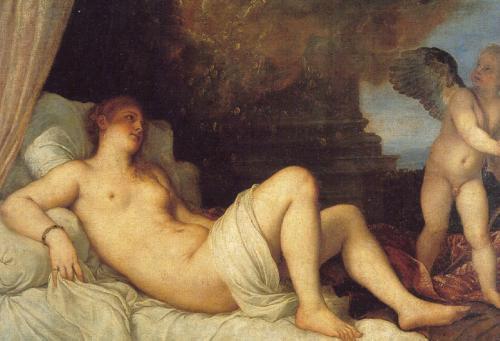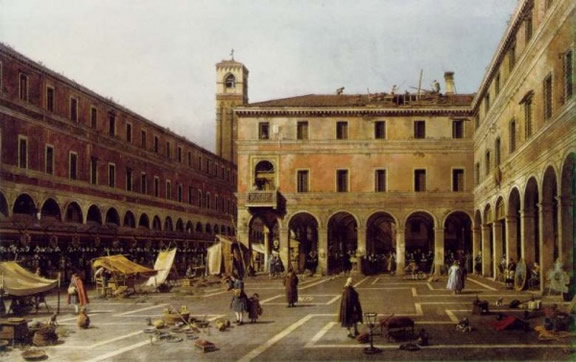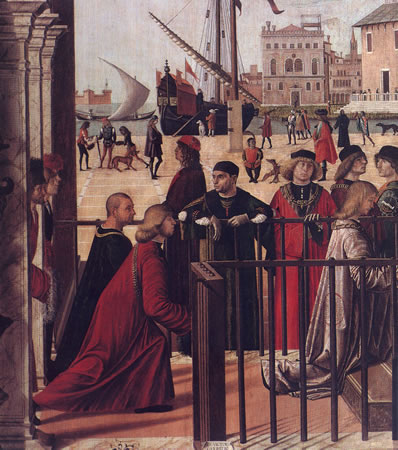Philippe De Commynes, Ambassador of King Charles VIII of France, described Venice at the end of the 1400s as “the most triumphant city that exists and the Canal Grande the most beautiful and best built anywhere in the world”.
In the cycle of canvas paintings by the Scuola Grande di San Giovanni Evangelista we see an illustration of De Commynes’ words: a picturesque and teeming humanity invades Venice. The authors of these works are Carpaccio , Gentile Bellini , Bastiani, Diana and Mansueti.Gondola. A lazy white dog on another gondola watches the spectacle with a surprised expression. On the banks are gentlemen, representatives of the middle class and members of the Compagnia della Calza, an association of young people dedicated to fun and culture. This vision of the city is reflected in the diaries of Marin Sanudo, a young educated Humanist, and the map by De Barbari dated 1500.
In 1529 Venice was the second largest city in Italy and the third largest in Europe in terms of its population.
At that time the nobility favoured silk, damask and velvet.
For solemn occasions, they wore scarlet , crimson, purple or gold togas. Even the clergy adopted gaudy colours. The wives of noblemen and wealthy bourgeois showed off their financial status through their sumptuous clothes and precious jewels.
Venice was thus the capital of fashion in the 1500. Venetian women were distinguished by the colour of their hair, a copper blond called “Titian blond” owing to the fact that it is a regular feature in Titian’s paintings .
The festivities in honour of the visit by King Henry III of France to Venice gave the Serenissima the chance to show off its power and magnificence to the world.
Upon arrival at Lido, the king, shaded by a canopy supported by six St. Mark’s Procuratori, passed under a triumphal arch by Palladio to board the Bucintoro galley which took him to Ca' Foscari, his residence.
From the windows of this palace he could admire the unique spectacle of numerous boats gathered in the canal below.
Throughout the night thousands of lights lit up the scene and concerts were held every evening under the windows. A magnificent regatta was organised. A floating furnace was created in the middle of the Canal Grande, where precious items of blown glass were produced for three consecutive nights.
In the 16th Century, elegant yet scarcely dressed courtesans used to sit in gondolas under the "Felze", during the Festa della Sensa, organized as a procession on water of Rio Sensa.
This custom was originally tolerated by the authorities because the canal was in a suburb of the city, but it was later brought to the Grand Canal and so, exasperated by their behaviour, the members of the Council of Ten ("Consiglio dei Dieci") banned them from travelling in gondolas with felze, from buying houses in the vicinity of the Canal Grande, from wearing silk and jewellery, from going to Mass and having servants less than thirty years old. But it was pointless trying to enforce the law: courtesans often rented apartments in Palaces near the Canal Grande, incognito, adopting the name of the noble proprietors and threatening those responsible for upholding public morals.
"The patricians no longer wear togas…. Superficiality and luxury are such that they make one sick" wrote Angelo Maria Labia (prelate, poet and member of a new family of Veneto patricians) in his diary at the end of the 18th Century.
Year 1750 : the Venetian nobility enjoys great wealth, yet Venice is full of beggars.
State officials, once famous for their devotion to the Republic, were now infamous for their corruption. Venice, despite its long decline, attracts visitors from all over the world , but the ostentatious and extravagant luxury fails to disguise a deteriorated situation.
Venetian civilization is dying.
Michelangelo Mandich









